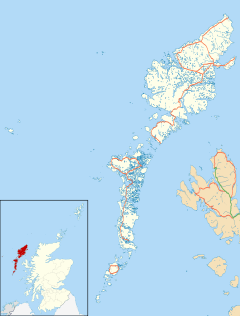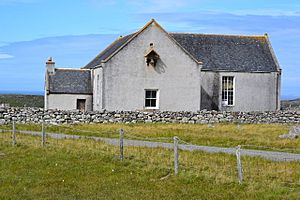Timsgarry facts for kids
Quick facts for kids Timsgarry
|
|
|---|---|
 |
|
| Language | Scottish Gaelic English |
| OS grid reference | NB050338 |
| Civil parish | |
| Council area | |
| Lieutenancy area | |
| Country | Scotland |
| Sovereign state | United Kingdom |
| Post town | ISLE OF LEWIS |
| Postcode district | HS2 |
| Dialling code | 01851 |
| Police | Northern |
| Fire | Highlands and Islands |
| Ambulance | Scottish |
| EU Parliament | Scotland |
| UK Parliament |
|
| Scottish Parliament |
|
Timsgarry (which is Tuimisgearraidh in Scottish Gaelic) is a small village in Scotland. You can find it on the Isle of Lewis, which is part of the beautiful Outer Hebrides islands. Timsgarry is famous for its old church, Baile na Cille, and the Uig Museum. The museum is special because it displays amazing replicas of the giant Lewis Chessmen, which were found nearby long ago in 1831!
Contents
Where is Timsgarry Located?
Timsgarry is on the western side of the Isle of Lewis. It sits right on Uig Bay, a lovely coastal area. The village is about 54 kilometers (33.5 miles) southwest of Stornoway, the main town on the island. The Erista River flows into the sea right here. The sandy coastline is known as Uig Sands.
A Look Back in Time: Timsgarry's History
People have lived in the Timsgarry area for a very long time. In 1991, archaeologists found pieces of ancient pottery from the Iron Age at a place called Dun Borranish, just south of the village. This shows that people were living and making things here thousands of years ago!
Important Places to See in Timsgarry
Baile na Cille Church
Timsgarry is home to the Baile na Cille Church, which is part of the Uig area. This church was built in 1724. Before that, there was an even older church called Capail Beag on the same spot. Timsgarry also used to have a bigger chapel called Capail Mor further west. The old house where the church minister lived is still there, next to the churchyard.
Teampall Chrìosd: An Ancient Church Ruin
Even older than Baile na Cille are the ruins of Teampall Chrìosd, or St Christopher's Church. These ruins are located west of Timsgarry. There's a local story that this burial ground was once just a bare rock. A man named Eidheann supposedly carried soil from a nearby hill, Cnoc Eidheann, to create the mound where the church now stands. People also say that a very old pagan temple or fort might be hidden under this mound. For a long time, this burial ground was thought to be only for the Clan MacAulay family. Today, it is a protected historical site.
Uig Museum and the Famous Chessmen
The Uig Museum is located in Timsgarry, inside the community center. This museum is a great place to learn about the local history and archaeology. It has amazing replicas of the Uig Chessmen. These famous chess pieces were found in the sands nearby in 1831! They are from the 12th century and were made by Vikings using walrus ivory and whale teeth. They are very important historical artifacts.
Uig Lodge Golf Course
To the southwest of the village, you'll find the Uig Lodge Golf Course. It overlooks the beautiful Uig Sands Bay. This golf course was first created in 1930. It has been restored and is now used only by guests staying at the Uig Lodge hotel.



